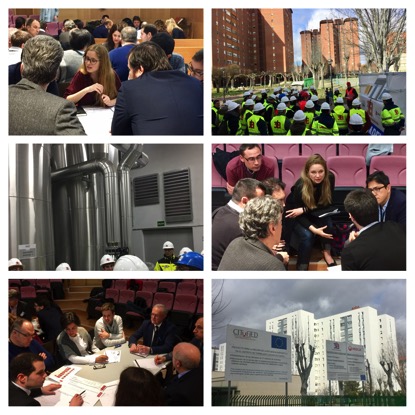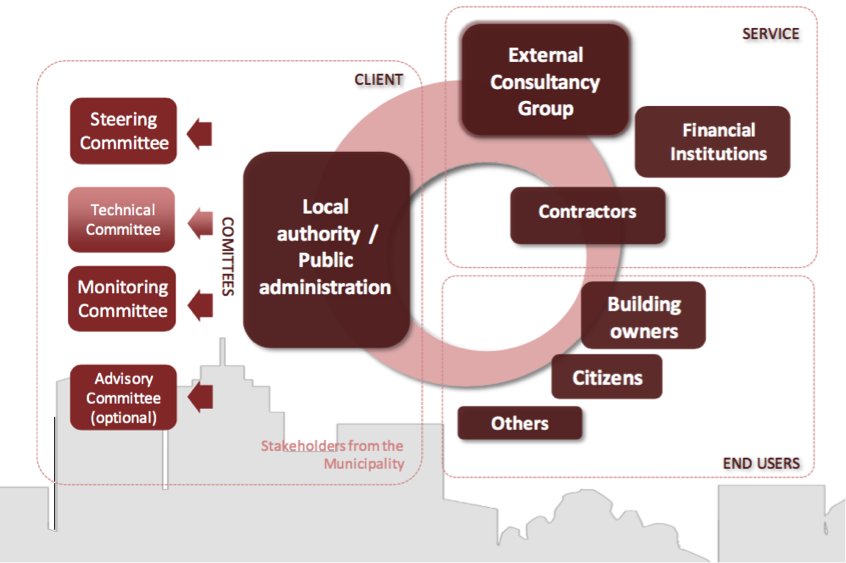Twenty-five participants from 19 cities met with the project consortium on 1 March 2017 in Laguna de Duero, Spain to do just this…

From Avila to Tartu and Botkyrka to Udine, the vast number of differences is clear. Hearing each speak, climate, population, demographics, budgets, financing and ownership models as well as the precise nature of their individual energy efficiency targets were as diverse as their languages and cultures. Governance, too, was quite different with local leadership on energy issues falling to everything from agency style incubators to regional energy ministries and entrepreneurial local authorities. However, their desire to give recognised leadership in the European drive for smarter cities and energy efficiency brought them all together under the CITyFiED community for a lively exchange and study tour.
In preparing the meeting and aiding CITyFiED replication work, 10 of the project’s cluster cities conducted interviews and workshops with stakeholders on non-technical barriers and better identify future solutions. These were then built upon in presentations and open discussions. As often the case, another common factor was mobilising the high investment costs needed to transform building stock and deliver energy innovation. Long payback periods and lack of financial incentives can be a hindrance for single buildings, let alone whole districts and cities. For some, a crisis in the real estate market or even – almost ironically – a mild climate were highlighted as additional factors making profitability and payback of energy retrofitting investments even more challenging. Public-private partnerships with energy service companies or energy saving contracting were common; but many advocated looking at finance in the bigger picture. This included reducing costs through district level purchasing and synergies or integrating other energy efficient interventions such as public lightning and sustainable mobility. Many from the CITyFiED community also highlighted the importance of fiscal incentives and benefits. Here, low interest loans, citizen crowd sourcing, ethical investment funds and grouped purchasing of installations and services were some of the creative elements used.
If financing is complicated and critical, then social acceptance also fitted the bill. A lack of awareness and interest; difficulty to communicate and involve residents and potentially major roadblocks to make a project time-consuming and expensive were all raised in a series of open discussions on non-technical barriers held in advance of the meeting as part of CITyFiED’s replication work. Starting the dialogue early and maintaining it often with a range of events and opportunities to contribute seemed to give the best results, but varied ownership across apartments and limited professional communication skills, especially in smaller organisations, kept this issue on high alert among the cities.
A sharing session with speakers from Spain, Sweden, Estonia, Italy and Turkey built on all these insights. Raimond Tamm from Tartu and the SmartEnCity project underlined the need for tangible solutions and achievements. For him, doing is convincing and residents need practical and substantiated reference cases to be convinced about the benefit of energy retrofitting. In Turkey, managing political, social and economic risks and understanding different points of view and their potential outcomes was good project management practice for all initiatives. Professor Gianfranco Rizzo from Salerno stressed the city needed a strong multi-disciplinary approach to meet the many societal and environmental challenges ahead. This included everything from storage and micro-generation, to solar roofing and solidarity purchasing groups.
Piecing district transformation together – a model for success?
Beyond the exchange, CITyFiED is attempting to give all of these diverse elements ‘freedom within a framework’ – to establish a credible methodology for district renovation and aid for city transformation. Under the leadership of partners Acciona, Tecnalia and CARTIF the CITyFiED methodology aims to facilitate the replicability and mass market deployment of energy-efficient retrofit of districts. It is being built using state of the art knowledge and insight, experiences at the three demonstration sites and a range of inputs and challenging co-creation from the City Cluster and Community of Interest. The procedure is composed of several phases and a decision making process that aims to understand the city’s objectives and needs in to deliver a set of customised ‘Strategies for the Sustainable Urban Renovation’ at district level with the energy efficiency as the main pillar and local authorities as clients.
When being road tested and challenged during the meeting 1 March 2017, in general terms it was agreed that the methodology is comprehensive and adaptable to any city. Participants gave positive feedback on the support to the decision making process in cities. On the other hand, some improvements were suggested to give more relevance to communication activities, professional stakeholder groups and chambers of commerce.
Refining and testing the CITyFiED Methodology will go through numerous phases to make a robust and relevant tool. A first public briefing on the approach is due in Autumn 2017. Interested parties can follow the @Cityfied_eu twitter feed or LinkedIn page to be sure not to miss developments or contact Cristina Criado cristina.criado.camargo.ext@acciona.com

The CITyFiED Methodolgy ecosystem
21 March 2017